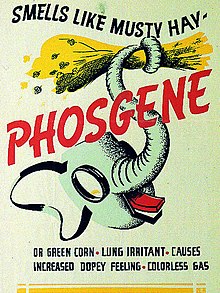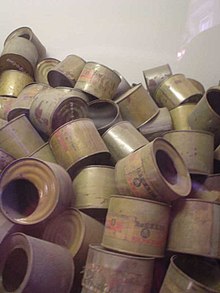Blood agent
A blood agent is a poisonous chemical. A blood agent makes it impossible for a person's blood to hold oxygen and bring it to the rest of the body.[1] Every part of the body needs oxygen to survive. Blood agents can cause life-threatening symptoms like seizures or coma, which happen because the brain is not getting enough oxygen. In high enough doses, blood agents can make a person suffocate.[2]
When they are used on purpose to kill many people, blood agents are weapons of mass destruction (WMDs).[3]
The most common types of blood agents are chemical compounds that include cyanide. However, other blood agents are based on arsenic.[2]
Types of blood agents
There are many different blood agents. Below is some information about the blood agents that are most likely to be used as weapons of mass destruction:[4]
| Blood Agent | Liquid, Gas, or Solid? | Smell | Notes |
|---|---|---|---|
| Hydrogen cyanide | Liquid or gas | Almonds | Boils just above room temperature, at 25.6 °C (78.1 °F) |
| Cyanogen | Gas | Almonds | Also irritates the eyes and respiratory system Easily changes into cyanide |
| Cyanogen chloride | Liquid or gas | Strong bad smell | Also irritates the eyes and acts like a choking agent Gets through gas mask filters more easily than any other blood agent[5] |
| Arsine | Gas | Garlic | Created when arsenic is mixed with an acid |
| Vinyl arsine | Liquid | Bitter smell | Also acts like a blister agent |
| Phosgene | Liquid or gas | Freshly cut grass or moldy hay | Also acts like a choking agent |
All of these chemicals are colorless, except for phosgene. Phosgene gas is colorless, but liquid phosgene is a very light yellow.[4]
According to a book on the history of chemical weapons, the most toxic and effective blood agents are hydrogen cyanide and phosgene; followed by cyanogen and arsine; then cyanogen chloride; and finally vinyl arsine.[4]
How they work

Usually, the bloodstream carries oxygen from the air we breathe to the entire body. The cells in the body need oxygen to survive, and they also need to get rid of carbon dioxide. (Carbon dioxide is left over when cells make energy; too much of it is poisonous.) Usually, cells pick up oxygen from the bloodstream, and send carbon dioxide out into the bloodstream. This is called gas exchange.[6]
Blood agents prevent gas exchange. They keep oxygen from getting into the body's cells. Without oxygen, cells die. If a person gets a high enough dose of a blood agent, they will suffocate because the oxygen they breathe in cannot get into the body's cells.[5]
Exposure
"Exposure" means that a chemical touched or got into a person's body. That person has been "exposed" to the chemical. Most people who are exposed to blood agents breathe in or swallow the chemical.[7] This can happen accidentally or on purpose.
For example, there are cyanide compounds in cigarette smoke and in smoke from many building fires. Also, cyanide compounds and arsine are used in pesticides. Most exposures to arsine happen accidentally to people who work around these chemicals.[5][8]
Usually, when blood agents are used as a weapon of mass destruction, they are sprayed into the air, so people will inhale them.[7]
Signs and symptoms
When a person is exposed to a blood agent, their symptoms will depend on a few things:[5]
- How much of the blood agent the person breathed in or swallowed (this is called concentration)
- How long the person was exposed to the blood agent (duration)
If a person is exposed to a small amount of a blood agent, their symptoms may not be life-threatening. For example, they may get confused, feel very tired, or have a headache, nausea, and vomiting.[8][5]

However, if a person is exposed to a high dose of a blood agent, they can have much more serious symptoms, including:[8][5]
- Seizures (caused by the brain not getting enough oxygen)
- Paralysis
- Cardiac arrhythmias (caused by the heart not getting enough oxygen)
- Coma (because the brain is not getting enough oxygen to keep the person conscious)
- Respiratory failure
Blood agents act very quickly. If a person gets a high enough dose, they will start having these symptoms just a few seconds after being exposed.[7] They can die in minutes - or even seconds - from respiratory failure.[9][5]
Treatment
There are a few different antidotes to cyanide poisoning. The cyanide antidote kit used most often in the United States includes three medications: amyl nitrite and sodium nitrite, which attach to cyanide and change it to a less dangerous chemical, and sodium thiosulfate, which turns cyanide into a harmless chemical that a person can urinate out.[10]
A form of vitamin B12 that is made by bacteria, called hydroxocobalamin, is also an antidote to cyanide. It changes cyanide into regular vitamin B12.[10]
There are no antidotes for arsine or phosgene.[9][11] Medical professionals can only give "supportive care," which means they can only treat arsine poisoning's symptoms. For example, they can give oxygen through a mask; give medications for cardiac arrhythmias; and do dialysis for kidney failure.[9][11]
Use in war and execution

The first blood agent to be used as a weapon of mass destruction was phosgene.[12] Phosgene was first used by the German Army to attack the British Army in 1915.[12] After that, phosgene was used often during World War I. Countries on both sides of the war - including Germany, France, the United Kingdom, and the United States - used phosgene to attack enemy soldiers. Often they mixed it with chlorine, with the goal of killing more people.[12] Phosgene caused about 85%[13] of the 100,000 deaths caused by poison gas[14] during the war (a total of about 85,000 deaths).
In 1919, the British Royal Air Force dropped arsenic gas on Bolshevik soldiers during the Russian Civil War.[15]
Phosgene was also used often by the Imperial Japanese Army against China during the Second Sino-Japanese War (1937-1945).[16]
During the Holocaust, the Nazis used a form of hydrogen cyanide called Zyklon B to kill people in the gas chambers at their death camps and concentration camps.[17]
After nerve gases were discovered, blood agents were not used as much. However, in the 1980s, Iraq used cyanogen chloride against Iran in the Iran-Iraq War.[14]
Starting in 1924, the United States has used hydrogen cyanide in gas chambers to execute prisoners who were given the death penalty.[18] Most states now use other ways of executing people. However, execution by hydrogen cyanide is still legal in six states.[19]